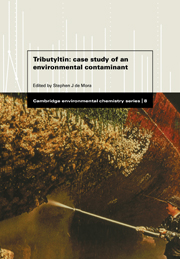Book contents
- Frontmatter
- Contents
- Contributors
- Preface
- 1 The tributyltin debate: ocean transportation versus seafood harvesting
- 2 Industrial manufacture and applications of tributyltin compounds
- 3 The analysis of butylated tin compounds in the environment and in biological materials
- 4 The occurrence, fate and toxicity of tributyltin and its degradation products in fresh water environments
- 5 The distribution and fate of tributyltin in the marine environment
- 6 Biological effects of tributyltin on marine organisms
- 7 TBT-induced imposex in neogastropod snails: masculinization to mass extinction
- 8 Environmental law and tributyltin in the environment
- 9 The efficacy of legislation in controlling tributyltin in the marine environment
- Index
9 - The efficacy of legislation in controlling tributyltin in the marine environment
Published online by Cambridge University Press: 04 August 2010
- Frontmatter
- Contents
- Contributors
- Preface
- 1 The tributyltin debate: ocean transportation versus seafood harvesting
- 2 Industrial manufacture and applications of tributyltin compounds
- 3 The analysis of butylated tin compounds in the environment and in biological materials
- 4 The occurrence, fate and toxicity of tributyltin and its degradation products in fresh water environments
- 5 The distribution and fate of tributyltin in the marine environment
- 6 Biological effects of tributyltin on marine organisms
- 7 TBT-induced imposex in neogastropod snails: masculinization to mass extinction
- 8 Environmental law and tributyltin in the environment
- 9 The efficacy of legislation in controlling tributyltin in the marine environment
- Index
Summary
Introduction
The tri(n-butyl)tin (TBT) cation, the active ingredient in some marine antifouling paints, is perhaps the most toxic substance ever deliberately introduced into natural waters (Goldberg, 1986). At seawater concentrations of only a few nanograms per litre, TBT disrupts reproduction in some molluscs, notably neogastropod whelks; and at levels of 10–100ng l−1 is toxic to many embryonic and larval organisms (Bryan and Gibbs, 1991). Throughout the 1980s, concentrations of TBT exceeded these levels in inshore waters at sites throughout the world, and in recognition of the accelerating ecosystem damage caused by TBT contamination, several countries legislated controls on its use as an antifouling biocide.
The hazard posed by a toxic substance is a function not only of environmental concentrations and its intrinsic toxicity, but also of its persistence. The resistance of a compound to environmental degradation processes increases the potential for long-range transport and uptake by non-target organisms.
TBT can now be considered to have exceeded initial estimates of its persistence and mobility in the marine environment, as its influence in offshore waters has been noted in several recent studies. Seas around the United Kingdom are perhaps the most intensively studied. TBT has been detected in the open surface waters of the North Sea (Coghlan, 1990). Although a survey of contaminants in seawater around England and Wales (Law et al., 1994) found TBT in only two out of six offshore samples, both sites were located offshore from major shipping rivers.
- Type
- Chapter
- Information
- TributyltinCase Study of an Environmental Contaminant, pp. 264 - 297Publisher: Cambridge University PressPrint publication year: 1996
- 23
- Cited by



